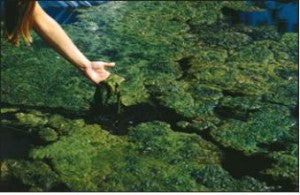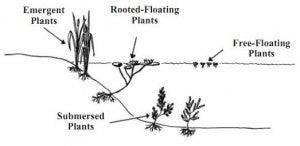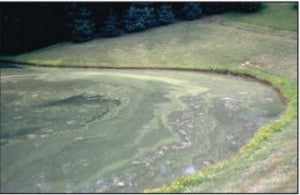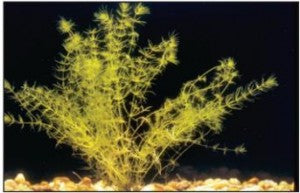Being a pond owner will most likely mean that you will experience some sort of aquatic plants along the way; whether they are wanted or not is a different story! And how you treat your unwanted aquatic plants is dependent on a proper identification of the plant.
Aquatic plants can be classified into two groups: algae and flowering plants.
Algae
Algae are simple structured plants that have no root systems, leaves or any of the other characteristics seen in higher flowering plant species. There are three general types of algae: planktonic or microscopic algae, filamentous algae and chara or stonewort.
Planktonic or microscopic algae (shown, right) can be identified by green, blue-green, yellow-green or red colored water known as a bloom. Blooms can encompass the entire surface of a pond and can resemble a pea soup consistency if left untreated.
 Filamentous algae (shown, left) initially form around the perimeter and the bottom of the pond in the spring in a mat-like fashion. They take on the characteristic of being stringy. This type of algae is very commonly observed on waterfalls, making surfaces slippery.
Filamentous algae (shown, left) initially form around the perimeter and the bottom of the pond in the spring in a mat-like fashion. They take on the characteristic of being stringy. This type of algae is very commonly observed on waterfalls, making surfaces slippery.
Chara or stonewort (shown, right) is easily confused with a flowering plant due to its similar appearance. However, it is considered algae. Chara grows best in very hard water and is often calcified and brittle.
Flowering Plants
Flowering plants have several differences from algae. For one, they are more structurally complex than algae. In addition to being able to produce flowers, they also have an internal conducting system which algae lack. Flowering plants are categorized according to where they are found in a body of water: submersed, free-floating, rooted-floating and emergent. While the category names might differ slightly from one publication to another, there location in the water is still the same.

Submersed plants are rooted in the bottom sediments and grow up through the water with their flowers or flowering spikes and sometimes emerge from the water. Some varieties of submersed plants have both underwater leaves and floating leaves. While these plants tend to be quite invasive, they do offer good shelter for game fish. Some of the most common submersed plants are shown below.
Free-floating plants can completely encompass the entire surface of the pond resulting in oxygen depletion in deeper water. The plants are found in nutrient rich waters; therefore, restricting nutrient inputs can help to alleviate this situation.
Rooted-floating plants are generally found in shallow water less than 4 to 5 feet deep. Common varieties are shown below.
Emergent or marginal plants are found along the shoreline line or the margin of a pond. Many of these plants spread rapidly by underground systems, as well as, by seed.



